Name Patrick Kennedy Role John F. Kennedy's son | Nephews John Schlossberg | |
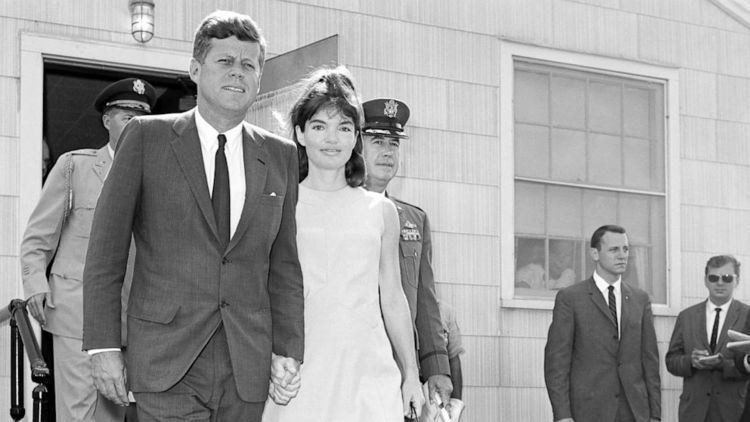 | ||
Cause of death Hyaline membrane disease Uncles Robert F Kennedy, Ted Kennedy, Joseph P Kennedy - Jr, James Lee Auchincloss, Thomas Gore Auchincloss Similar People John F Kennedy, Jacqueline Kennedy Onassis, John F Kennedy Jr, Caroline Kennedy, Robert F Kennedy | ||
August 10 1963 the funeral of patrick bouvier kennedy at holyhood cemetery brookline mass
Patrick Bouvier Kennedy (August 7, 1963 – August 9, 1963) was the last child of United States President John F. Kennedy and First Lady Jacqueline Bouvier Kennedy. He was the younger brother of Caroline and John Jr., and had a third sibling who was stillborn. Born prematurely, Patrick Bouvier Kennedy lived just over 39 hours before desperate attempts to save him failed, putting the First Family and nation into mourning. Three months later, his death was eclipsed by his father's assassination, but eventually his short lifespan led to innovations in treatment of premature infants, which gave rise to the pediatric subspecialty neonatology.
Contents
- August 10 1963 the funeral of patrick bouvier kennedy at holyhood cemetery brookline mass
- August 9 1963 press secretary pierre salinger announces the death of patrick bouvier kennedy
- Background
- Birth and attempts to save him
- Death and funeral
- Legacy
- References
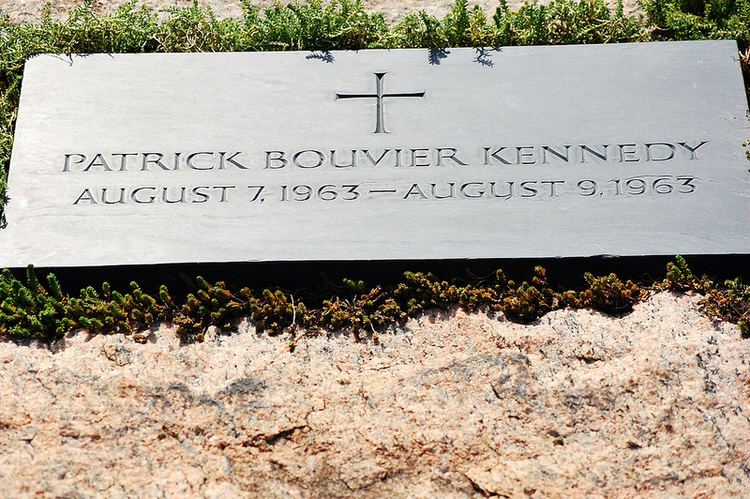
August 9 1963 press secretary pierre salinger announces the death of patrick bouvier kennedy
Background
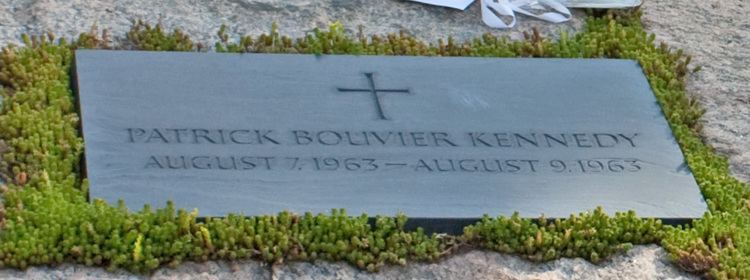
In August 1963, the 34-year-old Jackie Kennedy was in her third year as First Lady and in the third trimester of her fifth pregnancy. She had suffered a miscarriage in 1955, followed the next year by a stillborn baby girl they planned to name Arabella (after the Arbella ship). Two healthy children had followed, Caroline in 1957 and John Jr. in 1960. As John had also been premature, she asked her obstetrician, John W. Walsh, to accompany her when she and her children spent the summer in Hyannis Port, Massachusetts. Nearby Otis Air Force Base Hospital had also prepared a suite for her in case it was necessary.
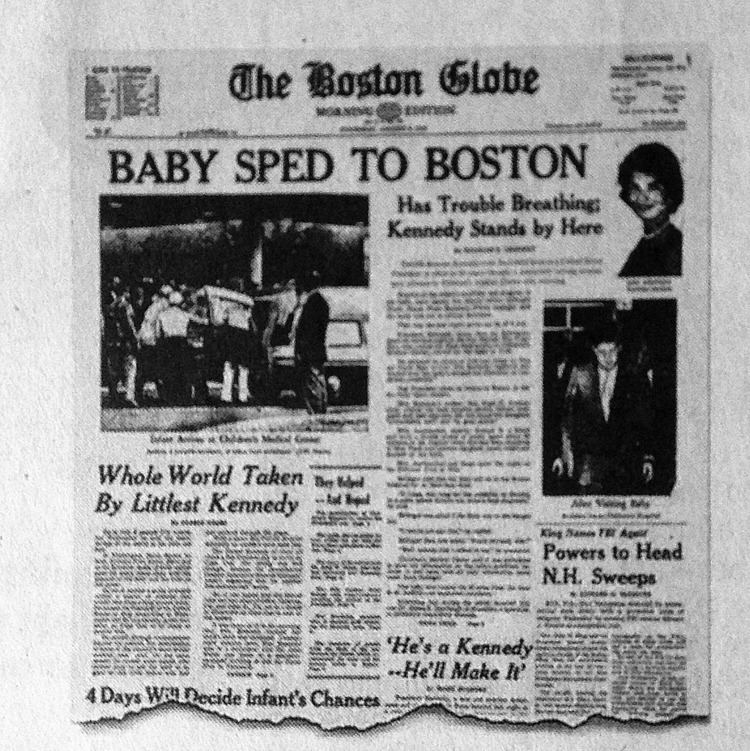
On the morning of Wednesday, August 7, Jackie Kennedy took Caroline and John Jr for a pony ride in Osterville, Massachusetts. While the children were riding, Kennedy felt labor pains. Walsh was summoned, and they were taken by helicopter to the Otis Air Force Base.
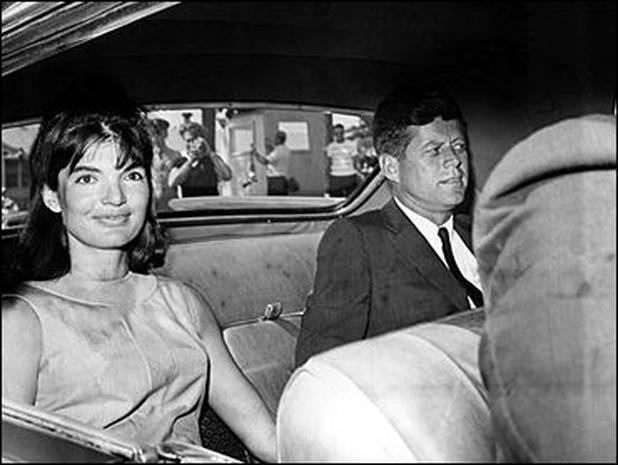
President Kennedy was at the White House at the time. August 7 was the 20-year anniversary of the day the Navy had rescued him in World War II after he had spent five days marooned on an island in the Pacific. Kennedy had been in command of Motor Torpedo Boat PT-109 when it was rammed by a Japanese destroyer, killing two of his crew. His heroics had helped launch his political career. PT-109 and August 7 were never far from his mind; he kept a scale model of the boat on a shelf in the Oval Office and each day used a metal tie clasp shaped like a torpedo boat, with PT 109 stamped across its bow.
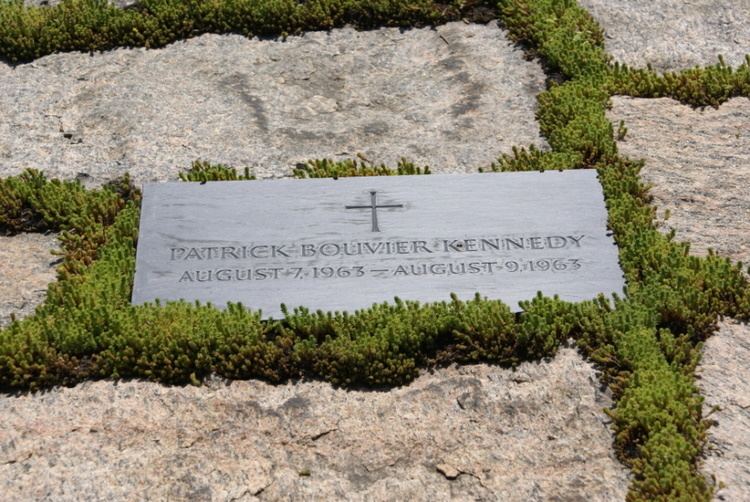
All of which may explain why Kennedy’s friend and fellow World War II naval veteran Ben Bradlee is certain that when the president’s secretary, Evelyn Lincoln, hurried into the Oval Office at 11:43 a.m. on August 7, a Wednesday, to report that Jackie had gone into premature labor on Cape Cod, there was "no way in God's earth" that he did not think, My child is being born 20 years to the day when I was rescued, a coincidence providing an additional emotional dimension to a day that would be among the most traumatic of his life.
Birth and attempts to save him
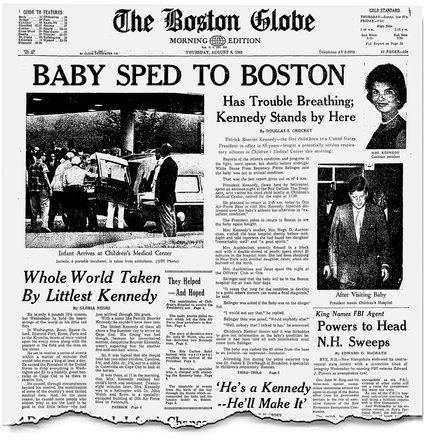
While his father was aboard Air Force One, Patrick Bouvier Kennedy was delivered by emergency caesarean section at 12:52 p.m. on August 7, 1963, at the Otis Air Force Base Hospital in Bourne, Massachusetts, where he was born five and 1/2 weeks prematurely. The caesarean section was performed by Dr. Walsh, who had also delivered John Jr. in 1960. His birth weight was 4 pounds 10 1⁄2 ounces (2.11 kg). He was the first baby to be born to a sitting U.S. president and First Lady since the 19th century.
Shortly after birth, Patrick developed symptoms of hyaline membrane disease (HMD), now called infant respiratory distress syndrome (IRDS). It was detected by breathing difficulties within minutes. James E. Drorbaught, the pediatric specialist at Boston Children's Hospital, was flown by helicopter from Boston to consult on his case immediately, and he recommended transfer to Boston. He was quickly baptized and named; he was named Patrick after his grandfather Joseph Patrick Kennedy (1888–1969) and great-grandfather Patrick Joseph Kennedy (1858–1929), and Bouvier for his mother's maiden name.
The president was allowed to quickly wheel the baby in an incubator to see the First Lady, and was taken away five hours after his birth. Accompanied by Dr. Drorbaught, Patrick was rushed by ambulance to Boston Children's Hospital, 70 miles (110 km) away in under 90 minutes. The transfer to the hospital in Boston was initially reported as a "precautionary measure," the White House said. His condition was accurately reported as HMD, but it was also reported it would take at least four days to assess his condition, and that he was being given medication to assist his condition.
However, at that time, all that could be done for a baby with hyaline membrane disease was to make efforts to keep the patient's blood chemistry as close to normal as possible. Led by Dr. Drorbaught, who stayed awake the entire time, the hospital attempted everything possible to save his life. Patrick was given hyperbaric oxygen therapy (HBOT), in which he was placed in a hyperbaric chamber filled with 100 percent oxygen and pressurized to greater than 1 atmosphere. At the time, it was revolutionary; the New York Times described it as "one of the newest interests of medical researchers".
Death and funeral
Patrick died at 4:04 a.m. on August 9—"despite a desperate medical effort to save him"—having lived 39 hours and 12 minutes. At the time of Patrick's death, the president was outside the room with the hyperbaric chamber with his brother, Attorney General Robert F. Kennedy. The First Lady, then 34, remained at Otis Air Force Base Hospital recovering from the caesarean section. She was told of her son's death by Dr. Walsh. (He would console her again after her husband's assassination; he was aboard Air Force One with her as she returned from Dallas with the president's body). She was given a sedative and slept until the president flew from Boston. Very little was said about the family's reaction; White House Press Secretary Pierre Salinger stated of the First Lady's condition, "Given the circumstances, her condition is satisfactory." The president, who had reportedly only slept four hours since the birth, was photographed arriving at Otis Air Force Base looking "grave and appearing tired".
A small funeral mass was held on August 10, 1963, in the private chapel of Cardinal Richard Cushing in Boston. The president's mother was in Paris and was told not to return for the funeral, though the First Lady's sister, Princess Lee Radziwill had already flown in from Greece before Patrick died. Cardinal Cushing, the Archbishop of Boston, performed the funeral mass, as he would for both John F. Kennedy, assassinated 75 days later, and his brother Robert F. Kennedy, assassinated in 1968. Siblings Caroline, then 5 years old, and John Jr., 2 1/2, did not attend.
The child was initially buried at Holyhood Cemetery in Brookline, Massachusetts, the president's hometown. His body and that of a stillborn sister, whom Jacqueline Kennedy called Arabella, were re-interred on December 5, 1963, alongside their father at Arlington National Cemetery, and later again moved to their permanent graves in Section 45, Grid U-35.
Legacy
The First Lady and the President were deeply affected by the death and it also affected their marriage. Upon their departure from Otis Air Force Base, the couple – seldom publicly affectionate – were seen holding hands. Secret Service agent Clint Hill recalled the couple having "a distinctly closer relationship" that was visible following Patrick's death. Press secretary Pierre Salinger believed that while the President and First Lady had been brought closer by the White House, even more so were they by the passing of their last child.
Patrick Kennedy's death, eclipsed a few months later by his father's assassination, did in time help spark interest in research on prematurity and led to innovations in the care of premature infants, which gave rise to the pediatrics subspecialty Neonatology.
